

BORDER COLLIE NAMES
AND ART GALLERY

Above, "Sleeping Collie" by William Walls
Notes: (?) f & m are purely my idea, except where traditional, f=female
m=male; b=black; bl=blue; w=white; tr=tri; r=red; sp=speckled; sb=sable;
dksb=dark sable or "hemp"; fn=fawn; rmr=red merle; blmr=blue merle;
Br=British; ME=middle English; C=Celtic; W=Welsh; S=Scots Dialect; G=Scots Gaelic; I=Irish;
N=Norse; CN=Cornish; IM=Isle of Man; NA=Native American; Bs=Basque;
@=already used i.e. my own dogs; *=like/would use, #=traditional;
T =textile/dyeing/fiber connotations; ->names that indicate speed.
 Right, a detail from "Effie Deans" by John Everett Millais.
Right, a detail from "Effie Deans" by John Everett Millais.
The earliest names that appear in the Stud Book of the
International Sheep Dog Society (ISDS) are
Sly, Moss, Hemp, Yarrow, Jed, Bute, Jen, Meg, Bess, Gyp, Tyne,
Ruby, Nell, Fan, Jess, Rye, Clyde, Tweed, and Wren. Many of these
names are evocative of natural features of the land, like rivers
(Jed, Tyne, Tweed, Clyde, etc.), and other indigenous properties of the
native countryside and climate (Moss, Glen, Mist, etc.). Thomas Farrall, writing in 1876 (On the Agriculture of the Counties of Edinburgh and Linlithgow, and the Industrial Progress and Development of These Counties During Recent Years, Aspatria, Carlishe) said:
Where sheep exist in large numbers, especially upon the hills, a well-trained dog is invaluable, so that in the south and southwest parts of the counties several well-bred collies are kept. The instinct and sagacity of the shepherd's dog have often been commented on. The old habit of calling the dogs after the name of a river is still in full force..."Tweed," "Yarrow," and other kindred names seem to be as common as they were before the whistle of the locomotive was heard in the Scottish valleys.
It is clear that the use of this type of name for working sheepdogs is ancient and traditional. Equally common are names that farm workers bore themselves (Nell, Bob, Meg, etc.) and often gave to their animals, farm dogs, draft horses, and family milk cows alike. The names that British shepherds traditionally gave
their working sheepdogs were short, possibly because they were more
easily distinguished at long distances. Thus, names like Nell, Cap,
Glen, and Meg have become conventional for Border Collies, but, as Marjorie Quarton says "Unless there is a prefix, the Bens, Roys and Nells are a researcher's nightmare..." (All About the Working Border Collie, Pelham Books, London, 1986). She also advises against flower names, like Daisy and Rose, which, she says "sound more like cows to me" (ibid.). However, when it comes to names, it appears to be a matter of personal taste.
Conventional names and their use have carried over to other countries where Border Collies are employed as working dogs. This is the case in the
United States, particularly among traditionalist shepherds.
However, here, it seems, we are willing to follow custom just so
far, so that while short names are still the norm, we have
expanded the vernacular to include American-sounding names like
Luke, Quest, Cody, Pete, and Sioux. These may not seem like
customary names to the purist, but they maintain the spirit of
the tradition.
 Left, a detail from "Lambing Time" by Basil Bradley shows a beautiful tricolored collie.
Left, a detail from "Lambing Time" by Basil Bradley shows a beautiful tricolored collie.
Longer, more lively names, often with kennel prefixes,
are frequently given to show or obedience dogs: Heelalong
Jalapena, Highland's Ring Side Riot, and Shoreland's Red Hot
Pepper were recent American obedience Border Collies. Keep in
mind that kennel names are not unheard-of in Britain and Ireland,
even among working dogs, as the famous names Wiston Cap,
Whitehope Corrie or Dryden Joe will attest. However the "call
name" of Cap, Corrie, and Joe are embodied in their kennel names
and are the traditional short Border Collie appellations, whereas
the call name of an obedience or show dog may be entirely
different from its registered name. Capricious names that appear
to disregard custom may offend purists by their apparent
flippancy, but in the context of obedience, agility or flyball, a
spirited name may be appropriate; they would likely be out of
place at the sheepdog trials, in the pasture, or on the
hill.
While there are no hard and fast rules, there are certain
standards that must be upheld for convention's sake. If a name is
embarrassing to say in public, indicates negative behavior or
looks, or is likely to be offensive, don't call your dog by it!
It might appear amusing at first, but you will probably regret it
later on.
We get the names on our list from a variety of sources,
including history, tradition, literature, folklore, and even
television (as you will see with the few names gleaned from Star
Trek). They all have something in common--they are short (most
are one syllable), and we think they are dignified. We'd be pleased
if you'd use any of them for your own Border Collies. This list is extensive,
but not necessarily exhaustive. If you can think of other names within the spirit
of the tradition that can be added to this list, please e-mail us at
carole@woolgather.org
If the names of stars and constellations for dog names interests you, go to the following page:
STAR NAMES
[A note on the "Art Gallery": We started adding pictures to this page to make it more interesting, and got carried away.
Hope you enjoy them!]
 Right, Border Collie by Dutch artist Rien Portvliet, 1935-1995
Right, Border Collie by Dutch artist Rien Portvliet, 1935-1995
- Ana f, C, earth mother (see Anu, another form)
- Abhainn f, G, "river", pronounced "AH-vun"
- Aeryn f, an alternate spelling for Erin, from sci fi TV show Farscape
- Aidan m,I,r, "little fire", pronounced "AY-dun"
- Ailsa f, G/N, a Scottish island
- Aine f,I, pronounced AWN-ya, "joy"
- Alec m, S, short for "Alexander"
- Alyx f
- Angus m, a county in Scotland
- Anna Liffey f, the river that flows through Dublin
- Annan f, river in Scotland
- Annie f
- Anu f, C, mother of gods, earth mother
- Aoife f, I, pronounced "You-fa", means "life"
- Argyll m or f, a region in the west of Scotland, blmr
- Arn m, N
- Arran an island off W. coast of Scotland
- Arrow
- Artan m, C, "little bear"
- Artio f, Br, "Bear", a goddess of healing
- Asa m, "healer"
- Ash m or f,*b,bl, blmr, sp
- August m or f
 Right, a Border Collie by British artist Lucy Dawson (a.k.a. "Mac"), ca. 1935
Right, a Border Collie by British artist Lucy Dawson (a.k.a. "Mac"), ca. 1935
- Bach m,W "small, dear"
- Banya f,I, "whiteness", pronounced BAWN-ya
- Bard #m
- Barra f, an island in the Outer Hebrides
- Baskin m,C "red headed"
- Bast T, textile fiber
- Beag f, G, "small" prounced BEK; also a goddess of magic, education and knowledge
- Bear m, totem Br.beast
- Beau m
- Beck a small brook
- Beech
- Beinn m,G, "mountain"
- Beith f,C, "birch"
- Belle #f, for "Daisy" Bellis perennis--see "Gowan"
- Bere *tr,sb,fn,S, "barley"
- Bess *@#f
- B'Etor f, one of the Duras sisters, Klingons on Star Trek The Next Generation
- Biddy f,I, diminutive of Brigit
- Birch
- Bix *T, short for "Bixa" Annatto, a red dye that S.American indians used as body paint
- Bjorn m,N
- Bjort f,N, "shining one", a sun goddess
- Blae S,bl, "blue","sharp", "keen"
 Right, "Breeze" by Canadian artist, Pat Nadarajah of Pawzitive Art.
Right, "Breeze" by Canadian artist, Pat Nadarajah of Pawzitive Art.
- Blair
- Blaise m
- Blaze m, r
- Blyth m,CN "wolf"
- Bors m, Lancelot's cousin
- Bov m,C,r, Bov Dearg was a king of the De Dannan, see "Dearg"
- Bow
- Bowen m, C, "archer"
- Bowe m
- Bowie m, a hill in Scotaland
- Boyd m,G, "blond"
- Braan a river in Scotland
- Brac m, especially in conbination with another dog named "Brica"
- Bracken *#f
- Brae f,S from G, a steep slope, often applied to a slope rising from water
- Bramble
- Bran *#m,b,W, "raven", aka Bendigeid Fran "Bran the Blessed"
- Brandi f,W, "brandy"
- Braq
- Braw m or f, S, "fine", "beautiful", "handsome", derived from the Gaelic word breagh.
- Breacan f,sp,tr,mr,T,G "tartan"
- Breagh f,G, "fine", "beautiful", etc.
- Breckin m, C, "freckled"
- Bree m,S, a broth or liquid; IM, "Brigid"
- Breeze ->
- Brenin m,I, "king"
- Brenn *f,r,S "to burn"
- Brenna f,b,I "raven"
- Bri f, C, a form of Brigit, goddess of health and healing, crafts, poetry
- Briar *m
- Brica f, especially in combination with another dog named "Brac"
- Brid f,I
- Brig f, C, a form of Brigit, goddess of health and healing, crafts, poetry
 Right, a painting of "Bessie the Sheepdog", a detail from a larger painting, artist unknown.
Right, a painting of "Bessie the Sheepdog", a detail from a larger painting, artist unknown.
- Braan a river in Scotland, tributary of the River Tay
- Brine salt
- Brigit f, Br, goddess of health and healing, crafts, poetry
- Briq
- Britt f
- Brochan #m, a druid
- Brock #*m,b, "badger"
- Broom f, yellow flower, pea family; also a river, a loch, and a town in Scotland
- Broq
- Bru
- Bryn #f,W, hill--like Brae in S
- Burn S, stream
- Burns for Robert Burns
- Bute m,f, an island off W. coast of Scotland

Right, a sheepdog guarding a package by late 19th century English illustrator, Harrison Weir
- Caber m,S, a pole or beam
- Cadbury *m,r
- Caer f,C, a swan maiden,fort or castle in W
- Cahir I, possibly meaning a battle lord
- Cairnie a river in Scotland
- Caleb m, a dog (Hebrides)
- CaleDon m
- Campsie hills in Scotland
- Canna an island off the west coast of Scotland
- Caper S,to frisk or dance
- Cara f, a Scottish island
- Carrick I, "rock"
- Carron f, a river in Scotland
- Cashel I, "castle"
- Cass *f, C "curly haired"
- Catha f,bl, "Raven"
- Cayenne "pepper",f,r
- Cayte f, a fancy spelling of Kate
- Ceana f,w,I "fair one", pronounced KEH-na
- Ceasg f,G, "Floss", also a mermaid
- Ceiba T, the Kapok family
- Ceilidh *f,G, a social gathering with singing
- Ceit *#f,G, "Kate"
- Ceo f or m,G, "mist", blmr
- Ceol m or f,G, "music"
- Ceri f,W, a river in Wales, the name of a Welsh sheepdog handler (daughter of Glyn Jones)
- Cermait m, the Celtic god of literature
- Chaff *T, vegtable matter in fleece

"Scotch Collie" by N. Drummond shows a tricolored collie and collie pup lying on their masters tartan plaid, a stick and hat (looks Tyrolean to me) on the right, indicating the shepherd is somewhere around there and will return soon.. This is more of the "Lassie collie"-type dog that was often called a "Scotch Collie" in the 19th and early 20th centuries.
- Chance *#m
- Chant *f
- Chase m ->
- Chess b
- Chex m or f
- Chief #m
- Chive
- Christie for the mystery writer, Agatha Christie
- Ciara f, "black", pronounced "kyara"
- Claudie f, a river in Pennsylvania
- Cilla f, as in Cilla Fisher, a traditional Scottish folksinger
- Clancy m,r,I "red warrier"
 Right, a detail from Richard Ansdell's 1866 "The Rescue".
Right, a detail from Richard Ansdell's 1866 "The Rescue".
- Clare f, a county in Ireland
- Cloud
- Cluaran G, "thistle"
- Clud f, C, see Clutha, below
- Cluny *S
- Clutha f,G, "the Clyde", a water goddess, personification of the river that runs through Glasgow
- Clwyd *m, a river in Wales (Welsh for "Clyde")
- Clyde @*m, river that runs through Glasgow
- Coda f
- Cody m
- Coe river in Scotland flowing through Glencoe
- Coll m, an island off the west coast of Scotland; also C, "hazel"; G, "high"
- Conall m,IM "strong as a wolf"
- Conic a hill in Scotland
- Connor m,I
- Conon m, a river in Scotland
- Copper m,r
- Corran m, G "arrow"
- Corc m,I "heart" or "crimson"
- Cormag m,I, pronounced COR-muk
- Corra f,I, goddess of prophecy

- Corrach m,I
- Cowie a river in Scotland
LI>Crieff a town and a hill in Scotland
- Crofter m
- Crottal r,T, bronze dye
- Cryda f,CN
- Cuda f, name associated w/the triple Mother goddess, prosperity, well being
- Cuillinn mountain range in S. Skye
- Curry r
- Cutch r,T, dye from the acacia, gives brown, khaki
Three old-fashioned collies, artist unknown. What I like about this is the collies are each a different type. The one at the rear, left, is a tricolor close to the type of today's Rough Collie (show type), but not quite there yet. The one at the rear, right, also a tricolor, is much closer to a Border Collie type. And the dog at the front, a sable, has a smooth coat but is closer to todays smooth-coated Border Collie than to a Smooth Collie.
 Right, "Border Collie"© by English artist,
D. John Wood.
Reprinted with kind permission of the artist.
Right, "Border Collie"© by English artist,
D. John Wood.
Reprinted with kind permission of the artist.
- Danna f, a Scottish island
- Dart ->
- Dash #m, ->
- Data m, Star Trek Next Generation android
- Dawn
- Dax *f, Star Trek Deep Space Nine science officer
- Dearg *m,r,G, "red"
- Deas *f,G, pronounced "Jace", meaning "south"
- Dee f,C, a water goddess, personification of the river Dee in Scotland
- Dera f,W "wild spirit"
- Derry *m
- Derwen f,W, "oak"
- Dewin m,W, "magician" or "wizard"
- Diarmuid m, nephew of Fionn
- Dill *,m,a druid
- Dillys f, W, "genuine"
- Dochas f,G, "hope"
- Dolidh f,I "Dolly"
- Dorcha *f,G, "dark"
- Dougal m,G "dark stranger"

- Draig m,W "dragon"
- Dru m,G, "oak"
- Druid m,G, starling or thrush, a Celtic priest or sorcerer
- Dubh m or f,G "black"
- Duff m,G "dark haired"
- Duir m or f,C, "oak"
- Duke *m
- Dulse S,f, kind of edible seaweed
- Dundee * m,r,T, seat ofJute industry in Scotland
- Dusk f,bl
- Dwyn m, C, god of love
- Dye T
- Dyke m
- Dylan m,W, sea god
Above right, "A Border Collie" by TS Cooper, thanks to Colin Kellam. Of this painting, Alan Harris from The Old Rectory, Petham Nr Canterbury, Kent, wrote to Colin Kellam, "The original painting is on display in Canterbury Library. The dog was known to Cooper...This painting, done in 1838, remained with Cooper throughout his life until his death in 1902. It strikes me as one of the finest paintings of an animal I have ever see." It is a beautiful painting, but I'm not altogether sure it is of a Border Collie. If it is, I don't think Cooper got the ears quite right.
 Right, "Winter Friends"© by English artist,
John Silver. Reprinted with kind permission from the artist.
Right, "Winter Friends"© by English artist,
John Silver. Reprinted with kind permission from the artist.
- Earrach f,G, "spring"
- Echo f, a Greek nymph, fell in love w/Narcissus
- Egan m,r,C "little fiery one"
- Eilean f,G, "island"
- Eilidh f,G "light", pronounced AY-lee
- Eira f,W, "snow"
- Eireann f,I, "Ireland"
- Elf *m
- Elfen f,W "element"
- Elphin I,m, patron of Taliesin and the person that gave him his name
- Enya f, I, "little fire"
- Eolas *f,G, "charm","knowledge"
- Eorsa an island off Mull
- Erin f,I, "Ireland"
- Eriskay f, a Scottish island
- Eriu f,I, one of 3 goddesses of Sovereignty, for whom Erin, Ireland, was named
- Eryn f, an alternate spelling of Erin
 Right, "A Sheepdog's Life" is an acrylic painting by Valerie Graves, a Taos,
New Mexico, artist, and is reprinted here with her kind permission. Copyright by
Valerie Graves, all rights reserved, prints available from Valerie's website
www.TaosArtist.com and www.BestDog.com.
Right, "A Sheepdog's Life" is an acrylic painting by Valerie Graves, a Taos,
New Mexico, artist, and is reprinted here with her kind permission. Copyright by
Valerie Graves, all rights reserved, prints available from Valerie's website
www.TaosArtist.com and www.BestDog.com.
 At right is "Shepherd's Delight"© painted by British artist, Gayle Mason
who breeds and shows Glenspey Rough Collies. It is reprinted here with
kind permission from the artist.
At right is "Shepherd's Delight"© painted by British artist, Gayle Mason
who breeds and shows Glenspey Rough Collies. It is reprinted here with
kind permission from the artist.
Above, "Scotch Collies" by English artist Basil Bradley (1842-1904).
 Right, "A Lovely Afternoon", a miniature painting of a Border Collie by Maine artist and Border Collie owner/breeder, Carol Scherr, who paints under the name of O. Colley. Reprinted here with kind permission from the artist.
Right, "A Lovely Afternoon", a miniature painting of a Border Collie by Maine artist and Border Collie owner/breeder, Carol Scherr, who paints under the name of O. Colley. Reprinted here with kind permission from the artist.
- Haar *m,bl,sp,blmr, the sea fog in Shetland
- Hamish *m, S from the G, the form of Seumas, James, used when addressing someone of that name directly, as in "Good morning, James!"
- susqueHannah *f--sheepdogs are traditionally named after natural phenomena, like rivers, so while this is not a traditional name, it is in the spirit of the tradition
- Hank m,T, as in "hank of yarn"
- Haw
- Hawk m
- Haze
- Hazy bl,blmr
- Hemp #*m,dksb,T
- Henna *f,r,T, a red dye
- Heron m
- Hett f, short for Hettie

- Hilde f, N, the Chief of the Valkyries
- Hirta f, the main island in the Saint Kilda group, West of Scotland
- Hogan m,r,C "fire"
- Hoy *#m, small island in the Shetland group
- Hrolf m
- Huath m,C, "hawthorn"
- Hue color
- Huw m,r,W "Hugh" means "fire"
- Hyll m, another spelling of hill; in Scotland, low mountains are called hills.
Right, a detail of a collie portrait by David Johnson.
 Right, "Motherhood" by British artist Mick Cawston. Copyright
Sally Mitchell Fine Arts 2006 and
reprinted here with permission from the holder of the copyright .
Right, "Motherhood" by British artist Mick Cawston. Copyright
Sally Mitchell Fine Arts 2006 and
reprinted here with permission from the holder of the copyright .
- Indigo *bl,blmr,T, blue dye
- Inneach f,G,T, "woof" as in "weft"
- Innis f,G, "meadow" or "island"
- Innse *f,G, "island"
- Io *f, a moon of Jupiter
- Iona *f, an island of Scotland
- Iorsa a river in Scotland
- Isla f, a river of Scotland
 "Shepherd's Dog" by late 19th century English illustrator, Harrison Weir
"Shepherd's Dog" by late 19th century English illustrator, Harrison Weir
- Jace f
- Jack #m
- Jade f
- Jake m
- Jane #f
- Jaq
- Jarl *m,N, "earl"
- Jasper *m
- Jax @*m, Anne McCaffrey character
- Jazz *f or m
- Jeannie #f
- Jed #f/m, river in Borders of Scotland
- Jedi m
- Jem *m
- Jenn *#f
- Jenna f,CN
- Jess #@*f
- Jesse m
- Jest
- Jestin m,W

- Jet b, ->
- Jett
- Jigg
- Jo f
- Jock m
- Joe m
- Joq
- Jord f, N, Mother Earth, mother of Frigga and Thor
- Joss m
- Jove m, L, another name for Jupiter, the supreme Roman god
- Juno f, L, Jupiter's wife, the Roman equivilent of the Greek goddess, Hera
- Jura *f, island off West coast of Scotland
- Jute T@f
- Jynx f
Above, right, a 1931 drawing of a collie by artist Diana Thorn. Born in Winnipeg, Manitoba, Thorn studied art in Munich and Berlin, but was detained by the German's at the beginning of the First World War. She escaped to England where she supported herself for several years as a reporter, librarian and writer, and began illustrating and etching. Moving to the United States in 1917, Thorn became one of the most recognized canine artists of the period.
 Right, a cereal advertisement card from the early 20th century.
Right, a cereal advertisement card from the early 20th century.
- Kae f, S. for crow
- Kagan m, a character in a Gordon Bok song
- Kale f, S, a type of cabbage
- Kane m,W "beautiful"
- Kate *f
- Keats for the poet
- Keeffe for the artist, Georgia O'Keeffe
- Keegan m,r,I "little fiery one"
- Keelta m, I, a runner, one of the Fianna
- Keir m,I "dark"
- Keith m,S,W "wood dweller"
- Kelp a seaweed used as a fertilizer in Scotland
- Kelsy *f
- Kelso m, a Scottish Borders town
- Kelty a Scottish town
- Kelvin a river in Scotland
- Kelyn a male name in W, a female in CN "holly
- Kemp T, hairy fibers in a fleece
- Kenaf T, a fiber, used mostly in papermaking
- Kenn m,W "clear water"

- Kensa f,CN "first"
- Kent m,W "white"
- Kep m, a traditional name
- Kermes m,r,T, an insect dye
- Kern m, Worf's brother on Star Trek TNG
- Kerra f,CN "dearest"
- Kerry *m, a town in Ireland and a river in Scotland
- Kersey f,T, a wool twill fabric
- Kes f, character on Star Trek Voyager
- Kidd m
- Kilda f, group of Islands off West Coast of Scotland
- Kilmory a river in Scotland
- Kira f, character on Star Trek Deep Space 9
- Kirk m,S "church"
- Kirsty f
- Kit f, a nickname for Katherine; or male, as in Kit Carson
- Kitt f
- Knell f
- Kona f
- Kudzu T, a fiber
- Kyla f,I "graceful"
- Kyle m,S. for a straight
- Kyloe m or f,S., small black cattle
- Kyte
Above, an illustration of a Bearded Collie or an Old English Sheepdog, artist unknown.
 Right, "Cap", a portrait by Colorado artist, Julia MacMonagle of
Innervoice Art Studio. Reprinted
here with kind permission by the artist.
Right, "Cap", a portrait by Colorado artist, Julia MacMonagle of
Innervoice Art Studio. Reprinted
here with kind permission by the artist.
- Lachlan m,G
- Laggan a river in Scotland
- Lal f, after Lal Waterson, diseased, one of the famous English family of traditional singers, the Watersons
- Lapis bl,T, blue dye
- Larch f, a desiduous conifer that is often used in Scotland for reforestation
- Lark f
- Lea *f, a pasture
- Leif * N,m
- Leith *m, river that runs through Edinburgh
- Leithen a river in Scotland
- Leof OE "dear"
- Letha f, old Celtic name for Brittany
- Lex m, Latin for "law"
- Lexy f,S, short for Alexandra
- Liath f,bl,blmr,G, "grey"
- Liam m,I
- Lichen f,T, dyestuff m
- Liffey f, the river that flows through Dublin
- Linc
- Lindis a tidal river in England whence commeth the name Lindisfarne

Right, a painting of a beautiful sable collie, artist unknown, but possibly John Emms. The features on this dog are so fine that it could possibly be a sheltie.
- Liddel a river in Scotland
- Lily f
- Ling a river in Scotland
- Linit f
- Linn @,f,S, "waterfall"
- Liza f
- Llew m,W, a sun god
- Llyn f,W, "waterfall"
- Llyr m,W, sea god
- Loch *m,S, "lake";
- Lochan *m, S, "small lake"
- Logo m
- Loki *m,N. trickster god
- Loireag *f,T, small water fairy that presides over the web (weaving)
- Lorcan m,I "fierce"
- Lore *m
- Lorn a region of W. Scotland
- Lossie a river in northeast Scotland
- Loyal a Scottish loch
- Luag m, a Celtic sun god
- Luath *m,G, "Swift", favorite dog of Cuchullin (though a hound), and also Robert Burns' collie who appears in his poem "The Twa Dogs", and who was named for Cuchullin's dog

- Luc *m
- Luce a river in Dumfries and Galloway in Scotland
- Lucy f,C "light"
- Lugh *m,I god of light, means "bright one", perhaps a sun deity;
- Luke *m
- Luna f, L, the goddess of the moon
- Lunan a river in Scotland
- Luq
- Lur f, Bs, Mother Earth
- Lursa f, one of the Duras sisters, Klingons on Star Trek The Next Generation
- Lute f
- Lynx f
Right, a 1902 painting of a black and tan collie, artist unknown.

 Far right, a lovely little painting of a sable or saddle-patterned collie. The painting is signed (right) but the name is hard to make out. We think it is "Mary L. Pulver"--if anyone knows this artist, please contact me at carole@woolgather.org. What struck us about this painting is that the dog looks exactly like Ruswarp, whose story we have on our "Forever Faithful: Memorials to Shepherds' Dogs" pages (if you go there, scroll down to the bottom of page 2).
Far right, a lovely little painting of a sable or saddle-patterned collie. The painting is signed (right) but the name is hard to make out. We think it is "Mary L. Pulver"--if anyone knows this artist, please contact me at carole@woolgather.org. What struck us about this painting is that the dog looks exactly like Ruswarp, whose story we have on our "Forever Faithful: Memorials to Shepherds' Dogs" pages (if you go there, scroll down to the bottom of page 2).
Right, "Guardian of the Flock" by British artist, Edwin Douglas (1849-1914). This is definitely more of a show collie-type than the collies in his other paintings.
 A post card with a Scottish theme from the early 20th century. Note the herding scene with "Scotch Sheep Dog", the Scottish Lion, heather, and the Buchanan tartan.
A post card with a Scottish theme from the early 20th century. Note the herding scene with "Scotch Sheep Dog", the Scottish Lion, heather, and the Buchanan tartan.
- Nanna *f, flower goddess
- Naw m,W
- Neahle f, I, pronounced "nail".
- Neeps m,S, "turnips"
- Nell f,#
- Ness *m, a Scottish loch, and a Scottish river
- Nessa *f,I "holy", CN "second", S female form of Ness "nose" or a portion of land sticking out into a body of water
- Nevis a mountain and a river in Scotland
- Niamh f,I pronounced Neeve, a health and healing goddess, "bright"
- Nin for the philosopher, Anais Nin.
- Njal m,N
- Njord *m,N sea god
- Nob m
- Nog *m, a concoction like eggnog, and a young Ferengi character in Star Trek Deep Space 9;
- Nomad m
- Nonna f,CN, pronounced NAW-nah
- Nord Danish for "north"
- Norn f, N, "fate" (the Norns are the Norse Fates)
- Norse m
- Noss m, a Scottish island
- Nuala f,I, short for Fionnuala, a goddess of mist and dawn, "white haired"
- Nuinn f,C, "ash"
- Nutmeg *f,r,rml
- Nyx f, goddess of night
 Another cereal card from the early 20th century.
Another cereal card from the early 20th century.
- Oak *m,r,T, bark=brown dye
- Oats
- Olcan m,I "wolf"
- Onchu m,I "mighty dog"
- Oran m,G, "song"
- Orla f,I,sb, "golden lady"
- Osage r, T, orange dye ages to copper
- Otter
 A rough collie painted in the "English School". The artist has signed his initials, but we don't know who he is. The collie in this painting is more akin to the working collies of the 19th century than the rough show collies.
A rough collie painted in the "English School". The artist has signed his initials, but we don't know who he is. The collie in this painting is more akin to the working collies of the 19th century than the rough show collies.
- Pace
- Pax f, goddess of peace
- Peat m,r, turns water red
- Peg f
- Pell m,N
- Penn m,W "from the peak"
- Pepper f,sp
- Puck m
- Quaen f, S traveller's term for "woman"
- Quair a river in Scotland
- Quark *m, Ferengi on Star Trek Deep Space 9
- Quay "dock"
- Quern m, a devise to gring grain
- Quest
- Quick
- Quinn m,I
- Qwest
 Right, a collie by English painter John Emms (1844-1912) of Lyndhurst, Hampshire.
Right, a collie by English painter John Emms (1844-1912) of Lyndhurst, Hampshire.
- Rabb *m
- Race m or f
- Rae f
- Rafe *m
- Raggs m,T, recycled wool
- Rain *f,sp,bl,blmr
- Rainich f G, "bracken"
- Rambler m
- Ramie sb,r,fn,T, fiber
- Random m
- Rannoch *m, S from G, "bracken"
- Raq *m, one of the collies in Susan Cooper's The Dark is Rising
- Rauk a Swedish term for a stone column created by natural erosion, like the
Old Man of Hoy in Orkney
- Raven *f,b
- Rede r,rmr,sb,fn
- Redpath *r,rmr, for Jean Redpath, folksinger
- Reed r,rmr,sb,fn
- Reekie m,bl,b,sp,S, "smokey"
- Reel
- Remy m or f, an alcoholic beverage
- Rhona f, alternate spelling of Rona
- Rime m or f, a coating of ice, as on grass and trees, formed when extremely cold water droplets
freeze almost instantly on a cold surface.
 A fruit crate label shows a sable collie.
A fruit crate label shows a sable collie.
- Rimy m or f,S, "frosty"
- Rissa f, the kittiwake, a sea bird
- Rhan W "fate"
- Rhaq *m, a Joanna Russ character and also the name of Eric Halsall's black sheepdog.
- Rhos *m or f,W, "moor"
- Rhum m, island in Inner Hebrides
- Rhun m, W
- Rhus *m,r,L, "Sumac" for tannens to improve dye fastness
- Rhyme
- Rhys *m,W "passion"
- Rionnag *f,G, "star"
- Righ *m
- Roane *f, G, a seal or silkie
- Rogue m
- Roke m or f, "mist"
- Rona f, a Scottish island, "sea"
- Ronan *m
- Rook m, a name with chess connotations
- Rora f
- Rory m,r,rmr, from G, "red head"
- Rose *f,r,rmr
 Right, detail from "Ring Around A Rosie" by English artist, Fred Morgan (1846-1927)
Right, detail from "Ring Around A Rosie" by English artist, Fred Morgan (1846-1927)
- Ross #m
- Rouge f,r,rmr
- Roux f
- Rover m
- Rowan *f,r,S, the mountain ash, also means "red haired"
- Roy #m
- Royal *m
- Royl m
- Ruby @,*,f,r,rmr
- Rudd *m,r,"red"
- Rue *f
- Ruel a river in Scotland
- Rufus *m,r
- Ruis m or f,C "elder" (the tree)
- Rune
- Rust m,r
- Ryan m,I
- Ryn m,W "ruler"
- Rysa a Scottish island
 A collie by John Henry Lorimer (1856-1936), a Scottish painter. If you take a close look at this painting you will see that Lorimer painted in his own reflection in the mirrow over the dog's head.
A collie by John Henry Lorimer (1856-1936), a Scottish painter. If you take a close look at this painting you will see that Lorimer painted in his own reflection in the mirrow over the dog's head.
- Sadie f
- Sadidh f, Gaelic spelling of Sadie
- Saff *f,r,sb,fn,T, short for "Saffron" or "Safflower"--yellow/red dyes
- Saga *f,N "all knowing", goddess of arts, education and knowledge
- Sage *m or f,bl,blmr,sb
- Saille f,C, "willow"
- Sal *f
- Saoirse f, I, pronounced "Shear-sah", "freedom"
- Sark m,S, "shirt"
- Sass f
- Sava f,I, wife of Finn who became a fawn
- Saxa f
- Scot
- Scota f, the ancestress of the Scots and Gaels
- Scotia f, another name for Scotland
- Sea bl,blmr
- Seamrag *f,G, "shamrock"
- Sean m, I, "God's grace"
- Sedge a grass
- Seil a Scottish island off the coast of Argyll
- Séla f, MI, "seal"
- Selkie *f
- Sett T, a measurment in weaving
- Seumas *m
- Sevi f,r,CN "strawberry", pronounced ZEV-ee
- Shadow m, b
- Shale a fine grained sedimentary rock
- Shamrock m
- Shannon f , river in Ireland, "little wise owl"
- Sharp m
- Shawna f
- Shawnee f
- Shep m
- Shona f an Island off the West Coast of Scotland
- Shony f,sea spirit from Lewis
- Shuna a Scottish island
- Shyla f

Right, a gorgeous sable collie in a detail from "Portrait of a Lady and her Collie" by English artist Heywood Hardy (1842-1933). If we can trust the color of the dog's nose, he may, in fact, be a brown sable.
- Sidheag f,I "wolf", prounced SHEE-uk
- Sigg
- Silk
- Silla an Inuit deity of the sky, wind, weather
- Silq
- Silver "My name," the selkie said,..."is She Who Swims the Silver Path of the Moon...but you can call me Silver." (The Secret Country by Jane Johnson)
- Sine *f,G, "Jean"
- Sionn m,r,I "fox", pronounced SHOON
- Sionna f, Irish spelling of Shannon
- Skald m, N for a poet
- Skara *f, S, same as Skerry, below
- Skerry *m or f, S, a rocky or sandy spit running into the sea
- Skew
- Skree a steep slope of loose rocks
- Skule f,NA, "meadowlark", a Klameth Indian goddess of wild birds
- Skye *f, a large island off the West coast of Scotland
- Slate bl, a fine-grained, foliated, metamorphic rock derived from shale
- Sleuth m
- Sliabh G, see "Brae"
- Snaw *w,S, "snow"
- Snell bl,w,blmr, S, "cold, piercing, fierce"
- Soar
- Sorcha f,I,G,sb, "clear, bright"
- Somerled m, from N, G, ancestor of Clan Donald
- Sorley m,G "summer wanderer"
- Sorrel r,fn
- Soy
- Speck
- Speir f, I "spirit", S "to ask" but of a seer
- Spice f
- Spin
- Spray
- Sprigg
- Sprint
- Sprite f, a water fairy
- Squire m
- Star f
- Stella
- Stone
- Storr m
- Stripe
- Suir
- Sul f,C, goddess of health and healing; another form of Sulis, below
- Sula f, as in Sula Sgeir, the Gaelic for Sule Skerry (Sula, Sule, etc. means gannet (the bird)); an island west of Sule Skerry, little more than a rocky outcrop.
- Sulis *f, esp. blmr, very important British water deity & healing goddess

- Sundance m,r
- Sundown m,r
- Sunset m,r
- Sunn Hemp m,r, T, fiber used for cordage, sacking, and paper
- SusqueHanna *f--sheepdogs are traditionally named after natural phenomena, like rivers, so while this is not a traditional name, it is in the spirit of the tradition
- Swain m
- Swan f
- Sweep #m
- Sweet #*f
- Swift
Right, collie by G. Hansh.
 A painting of two collies from an 1859 edition of the Illustrated London News.
A painting of two collies from an 1859 edition of the Illustrated London News.
- Tadhg m,I pronounced like tiger without the r
- Taff #m or f
- Tallow fn
- Talyn m, from the sci-fi program Farscape
- Tam #*m
- Tannin *r, T, old Europeon name for oak, tan dye that darkens with age
- Taran *m, W, thunder god
- Tarn *m, ME, from N, a small mountain lake, formed by glaciers
- Tarr m,b,dksb, fancy spelling of Tar
- Tartan T
- Tass #*f,G, "glass"
- Tay a river in Scot.
- Tea f,C, a goddess of the DeDanaan for whom Tara was named.
- Teagan f.
- Teg *f, W, "fair", "fine", "beautiful"
- Tegan f,C, a doe
- Teinn m or f,C, "holly"
 A collie by John Emms.
A collie by John Emms.
- Tern a sea bird
- Terra f
- Terracotta r
- Tess #*f
- Teviot *m, a river in Scotland
- Thatch m,fn
- Thegn m,N, a leader
- Thistle m or f
- Thor *m,N, thunder god
- Thorn
- Thrums f, the ends of the warp after the finished weaving is cut off
- Tieve f, C, "hillside"
- Till m, a Scottish river
- Todd m,r,"fox"
- Toll m or f
- Tummel m, a Scottish loch
- Tor *m, a rocky knoll
- Torr m
- Torsa a Scottish island
- Tory m or f,I, a tower-like rock
- Tramp m
- Traveller m, more # for hounds
- Trek m, as in "Star..."
- Treq

- Tressa f,CN "third"
- Treve m,C "prudent"
- Trew S "trowsers"
- Triffyn m.
- Trip
- Troll m
- Trow m
- Tru
- Tulla f,I "little hill", also the name of a loch in Scotland
- Tullich S, m, "hill
- Tundra f,bl
- Turf m
- Tux m
- Tweed #*m,tr,blmr,rmr,sb,sp
- Tyr m, N, god of war and justice, son of Odin
Right, by Sir Edwin Landseer (1802-1873), this engraving shows a collie guarding his master gear.
 Two collies in a farmyard scene, artist unknown. These two have the look of working collies on their way to become show collies. The one on the left is a handsome black and tan like we rarely if ever see today in the Border Collie, the other a saddle-patterned.
Two collies in a farmyard scene, artist unknown. These two have the look of working collies on their way to become show collies. The one on the left is a handsome black and tan like we rarely if ever see today in the Border Collie, the other a saddle-patterned.
- Ulf m
- Ulfin m
- Umbra f, "shadow"
- Unst one of the Shetland Islands
- Venn m,r, character in Hardy, the raddle man‹person who sold rudd, red dye, to farmers for applying to chests of ram so when the ram mounted a ewe, he marked the ewe on her butt, indicating that the ewe was bred
- Warlock m, a male witch
- Watt m
- Weaver T,m
- Webb f or m
- Weld *m,T, yellow dye
- Westra f

- Whimsy m
- Whin #*f, a flower
- Whisper
- Whiz
- Wicca f
- Willow *f
- Willy @*#m
- Wizard @*m
- Woad *m,T,bl,blmr, a blue dye
- Wold m
- Wren *f
- Wyn m,w,W "fair"
- Wynd *f
Right, "Waiting for Master". Quite frankly, I can't tell if this is a "Still Life with Collie" painting or a highly posed photograph. Whichever, it shows a black and tan collie.
- Yam r,fn
- Yarrow #f, a river in the Borders of Scotland
- Yeats *m for the poet
- Yell one of the Shetland Islands

- Ynys f,W, "island"
- Yore m
- York #*m
- Ythan a river in Scotland
- Zac m
- Zack m
- Zaq *m,# usually spelled "Zac" or "Zack"
- Zea f, a genus of grass, of which Indian Corn, Zea Mays is the only known species
- Zeal as in "full of zeal"
- Zeb *m
- Zee f
- Zeke m
- Zel f
- Zest as in "full of zest"
- Zig
- Zip
- Zoe f,Gr. for "life"
- Zoey f, an alternate spelling of Zoe
An illustration called "Two's Company" from a childrens' book (1890), artist unknown (thanks to Jan Hilborn).
Compiled and copyrighted © 1996 through 2009 by Carole L. Presberg
If you are interested in the names that appear in the ISDS Stud Books with the number of dogs/bitches
that have been registered by that name, go to Teun C. van den Dool's web page
Dog Names. Mr. van den Dool has done
a statistical analysis of all the ISDS Stud Books, an enormous job, and you will be able to see from
his list, what names have been most popular for Border Collies, at least in the UK.
THE OTHER WEB PAGES WE MAINTAIN
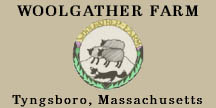
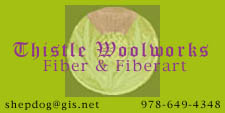
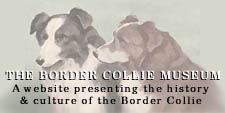
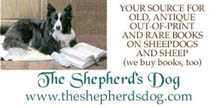
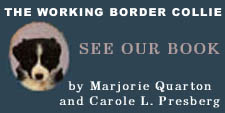
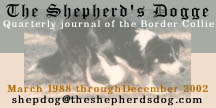
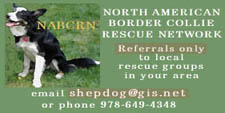
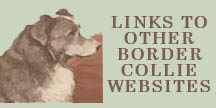
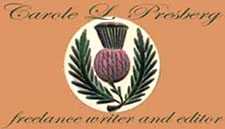
These web pages are copyright ©2013
and maintained by webmeistress Carole Presberg
with technical help from webwizard David Presberg
ALL RIGHTS RESERVED
If you are interested in using ANY material on this website, you MUST first ask for permission.
You may email us at carole@woolgather.org.
Last modified: July 14, 2013
carole@woolgather.org


![]()

Right, a detail from "Effie Deans" by John Everett Millais.
Left, a detail from "Lambing Time" by Basil Bradley shows a beautiful tricolored collie.
Right, Border Collie by Dutch artist Rien Portvliet, 1935-1995
 Right, a Border Collie by British artist Lucy Dawson (a.k.a. "Mac"), ca. 1935
Right, a Border Collie by British artist Lucy Dawson (a.k.a. "Mac"), ca. 1935  Right, "Breeze" by Canadian artist, Pat Nadarajah of Pawzitive Art.
Right, "Breeze" by Canadian artist, Pat Nadarajah of Pawzitive Art.
 Right, a painting of "Bessie the Sheepdog", a detail from a larger painting, artist unknown.
Right, a painting of "Bessie the Sheepdog", a detail from a larger painting, artist unknown.

 Right, a detail from Richard Ansdell's 1866 "The Rescue".
Right, a detail from Richard Ansdell's 1866 "The Rescue".

 Right, "Border Collie"© by English artist,
D. John Wood.
Reprinted with kind permission of the artist.
Right, "Border Collie"© by English artist,
D. John Wood.
Reprinted with kind permission of the artist.

 Right, "Winter Friends"© by English artist,
John Silver. Reprinted with kind permission from the artist.
Right, "Winter Friends"© by English artist,
John Silver. Reprinted with kind permission from the artist.
 Right, "A Sheepdog's Life" is an acrylic painting by Valerie Graves, a Taos,
New Mexico, artist, and is reprinted here with her kind permission. Copyright by
Valerie Graves, all rights reserved, prints available from Valerie's website
www.TaosArtist.com and www.BestDog.com.
Right, "A Sheepdog's Life" is an acrylic painting by Valerie Graves, a Taos,
New Mexico, artist, and is reprinted here with her kind permission. Copyright by
Valerie Graves, all rights reserved, prints available from Valerie's website
www.TaosArtist.com and www.BestDog.com.

At right is "Shepherd's Delight"© painted by British artist, Gayle Mason
who breeds and shows Glenspey Rough Collies. It is reprinted here with
kind permission from the artist.
 Right, a portrait of an early show collie by Frank Paton.
Right, a portrait of an early show collie by Frank Paton.
 Right, "A Lovely Afternoon", a miniature painting of a Border Collie by Maine artist and Border Collie owner/breeder, Carol Scherr, who paints under the name of O. Colley. Reprinted here with kind permission from the artist.
Right, "A Lovely Afternoon", a miniature painting of a Border Collie by Maine artist and Border Collie owner/breeder, Carol Scherr, who paints under the name of O. Colley. Reprinted here with kind permission from the artist.

Right, "Motherhood" by British artist Mick Cawston. Copyright
Sally Mitchell Fine Arts 2006 and
reprinted here with permission from the holder of the copyright .
"Shepherd's Dog" by late 19th century English illustrator, Harrison Weir

Right, a cereal advertisement card from the early 20th century.

 Right, "Cap", a portrait by Colorado artist, Julia MacMonagle of
Innervoice Art Studio. Reprinted
here with kind permission by the artist.
Right, "Cap", a portrait by Colorado artist, Julia MacMonagle of
Innervoice Art Studio. Reprinted
here with kind permission by the artist.



 Far right, a lovely little painting of a sable or saddle-patterned collie. The painting is signed (right) but the name is hard to make out. We think it is "Mary L. Pulver"--if anyone knows this artist, please contact me at carole@woolgather.org. What struck us about this painting is that the dog looks exactly like Ruswarp, whose story we have on our "Forever Faithful: Memorials to Shepherds' Dogs" pages (if you go there, scroll down to the bottom of page 2).
Far right, a lovely little painting of a sable or saddle-patterned collie. The painting is signed (right) but the name is hard to make out. We think it is "Mary L. Pulver"--if anyone knows this artist, please contact me at carole@woolgather.org. What struck us about this painting is that the dog looks exactly like Ruswarp, whose story we have on our "Forever Faithful: Memorials to Shepherds' Dogs" pages (if you go there, scroll down to the bottom of page 2).
 "Collie in a Landscape" by W. Marsden.
"Collie in a Landscape" by W. Marsden.

 A post card with a Scottish theme from the early 20th century. Note the herding scene with "Scotch Sheep Dog", the Scottish Lion, heather, and the Buchanan tartan.
A post card with a Scottish theme from the early 20th century. Note the herding scene with "Scotch Sheep Dog", the Scottish Lion, heather, and the Buchanan tartan.
 Another cereal card from the early 20th century.
Another cereal card from the early 20th century.
 A rough collie painted in the "English School". The artist has signed his initials, but we don't know who he is. The collie in this painting is more akin to the working collies of the 19th century than the rough show collies.
A rough collie painted in the "English School". The artist has signed his initials, but we don't know who he is. The collie in this painting is more akin to the working collies of the 19th century than the rough show collies.
 Right, a collie by English painter John Emms (1844-1912) of Lyndhurst, Hampshire.
Right, a collie by English painter John Emms (1844-1912) of Lyndhurst, Hampshire.
 A fruit crate label shows a sable collie.
A fruit crate label shows a sable collie.
 Right, detail from "Ring Around A Rosie" by English artist, Fred Morgan (1846-1927)
Right, detail from "Ring Around A Rosie" by English artist, Fred Morgan (1846-1927)
 A collie by John Henry Lorimer (1856-1936), a Scottish painter. If you take a close look at this painting you will see that Lorimer painted in his own reflection in the mirrow over the dog's head.
A collie by John Henry Lorimer (1856-1936), a Scottish painter. If you take a close look at this painting you will see that Lorimer painted in his own reflection in the mirrow over the dog's head.


 A painting of two collies from an 1859 edition of the Illustrated London News.
A painting of two collies from an 1859 edition of the Illustrated London News.
 A collie by John Emms.
A collie by John Emms.

 Two collies in a farmyard scene, artist unknown. These two have the look of working collies on their way to become show collies. The one on the left is a handsome black and tan like we rarely if ever see today in the Border Collie, the other a saddle-patterned.
Two collies in a farmyard scene, artist unknown. These two have the look of working collies on their way to become show collies. The one on the left is a handsome black and tan like we rarely if ever see today in the Border Collie, the other a saddle-patterned.

